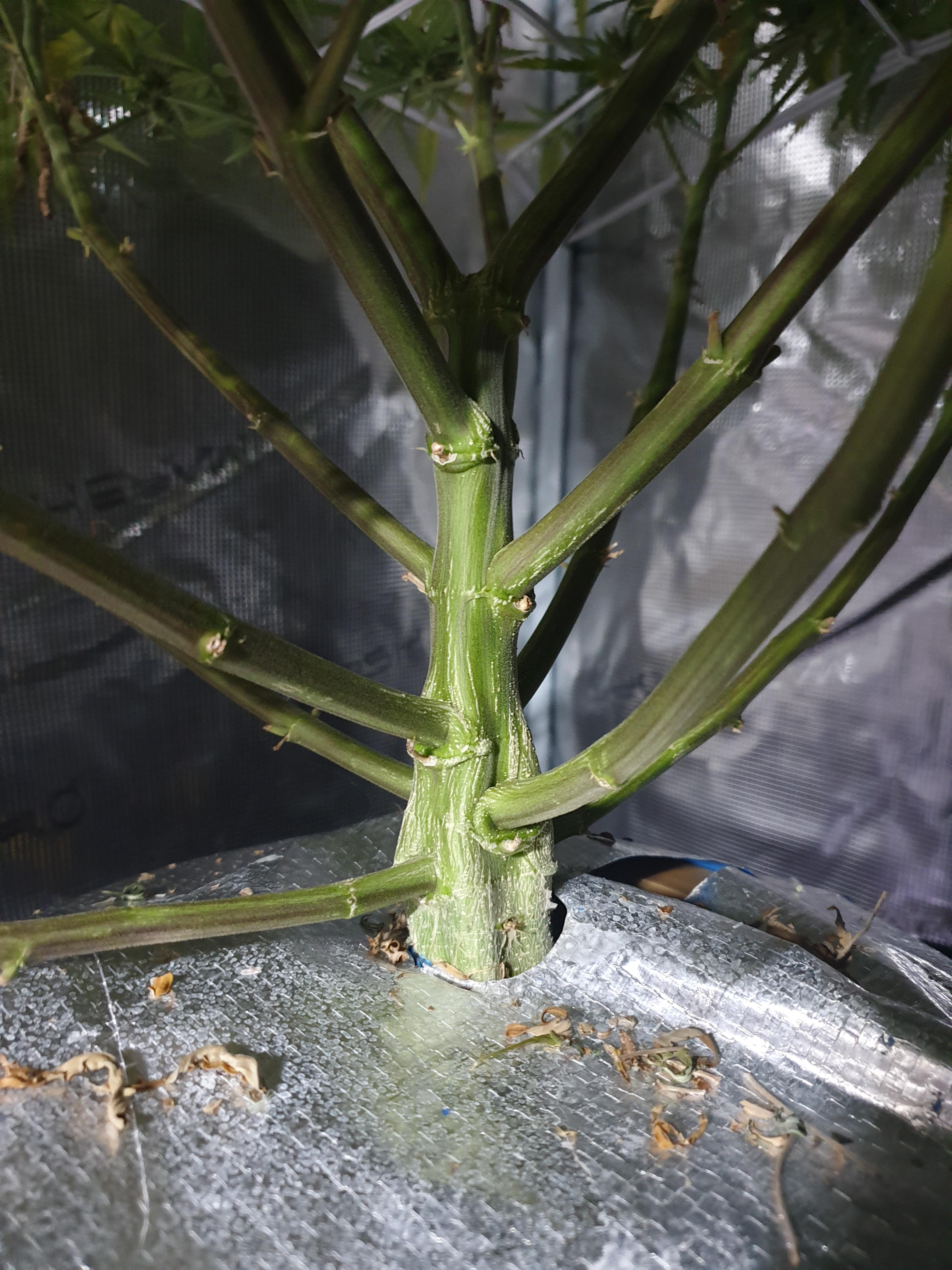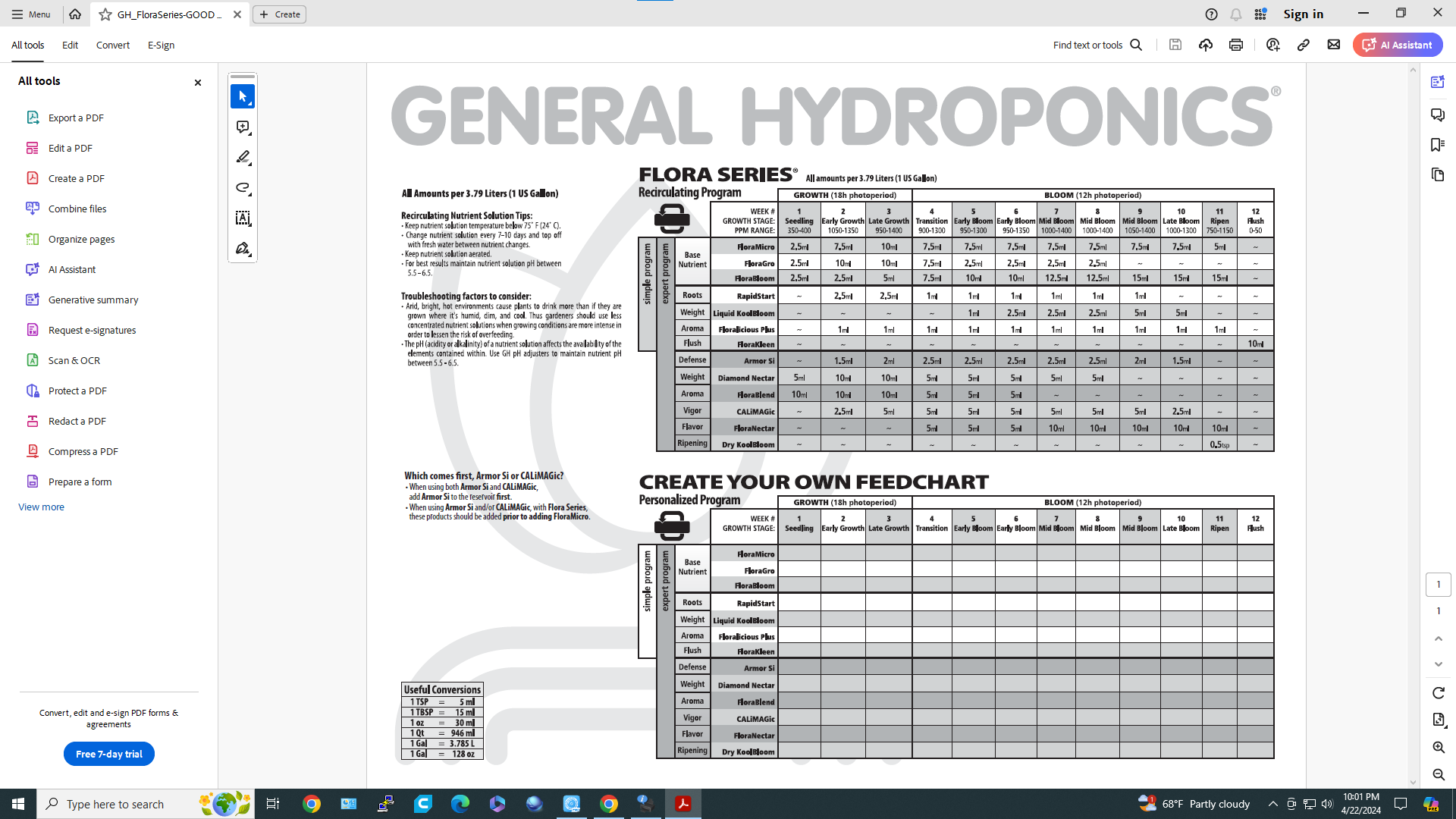Home › Forums › Grow Community – Ask Questions & Share Your Grow! › Specific Dosing Per Plant for RDWC Reservoir Tank
- This topic has 6 replies, 3 voices, and was last updated 1 year, 7 months ago by
chr is.
-
AuthorPosts
-
February 15, 2024 at 5:16 pm #3674
Kanga
ParticipantHi Guys!
I would like to ask you a question to get some clarity on dosing nutrients in a hydroponic reservoir tank (RDWC).
I understand that the fundamental nutrients, such as the NPK, would be measured by ppm/EC; however, when adding Si, CaMag, or other supplements, they have recommendations like 5 mL/1L or 2 mL/1L, etc.
I work as a nurse, and in paediatrics, we give medications to children based on their weight; e.g., medication is written for mg/1kg, and the child is 15kg, so the correct dose is 15mg.
I only grow two plants, and the dosing recommendations are broad and apply to the reservoir tank as a whole, not plant number-specific. So I am unsure if I am overdosing or underdosing and potentially wasting nutrients.
My understanding of the RDWC basic guideline per plant is between 5 and 20 litres for the reservoir. Does this mean I gradually start with 5 litres per plant, then work up to 20 litres while sticking to the recommended dose? Or should I try to find the recommended doses per plant size weekly? Eg. The application of Si no more than 200 ppm/week?
Can you please provide some clarity?
Thank you
Kanga
February 24, 2024 at 7:17 am #3712CamZ
ModeratorI highly suggest you check out green genes garden channel. His older videos are particularly helpful in understanding ppms for hydroponics. Sadly, not even he grows rdwc, but it can give you a better understanding of the process as a whole. Aside from telling you what I grow with and why, I can’t give you information specific to your situation because I didn’t design and am unfamiliar with your system. What I can tell you is that the reservoir application does not apply to number of plants, however, the ml per gallon reccomendation for nutrients is generally based off of drain to waste style gardening. For instance, 5ml per gallon of calmag is something you might want to run in coco, but you may run the lowest dose in rdwc.
- A cheat rule to understanding feeding in rdwc looks like this; measure out 5 gallons of ro or low ppm water.
- Note your initial ppm/ec.
- Add silica first always and do so at full strength, then calmag, then your base nutrient followed by additives if you run them.
- Add a full dose of each item as if you only had 2 gallons of water instead of 5.
- Measure ppm/ec and ph in your 5 gallon bucket.
- If less than your ideal range, add 1 more gallons worth of nutrients. If more, add water.
Once you have your initial ratio of water to nutrients figured out, divide your system volume by 5. Then next time you can add your water and add each item with its own 5 gallon bucket to prevent lockout problems. (For instance, 1st 5 gallon bucket you add all your silica, 2nd bucket has all the calmag, 3rd has base, 4th bucket additives.) Technically, you should mix every bucket as you go, but I have never had an issue doing it this way and it’s much faster. Just make sure you allow time for the salts to enter solution.</p>
- .4-.8 for early veg, .8-1.2 late veg, 1.2-1.6 for the remainder of flower. Generally 1.2 during stretch to limit node spacing and jump to 1.6 after week 3 to force more calyx growth. 5.8 ph is ideal in veg and 6.3 is best for flower, but anywhere between 5.5 and 6.5 is acceptable. Try to chase ph as little as possible.
- If your system is dialed in right then you can use the same water until ph starts to tank. I can typically go 3 to 4 weeks before encountering this issue, though your experience may vary. Generally, you will end up with an imbalance of nutrients at some point, typically excess sulfur, and that will start to make it hard to keep ph up. At this point, change your water. Again, the suggested practice is changing water every 7-10 days, but if you know what you are doing and understand some of the basic science on nutrient interaction you can go much longer.
- When it’s time to top off the res you read the ec and ph of your res. If your ec is high, add water only, if it’s low, add a stronger mix to hit your range. The longer you do it, the easier it gets to hit your target.
I hope this helps.
Regarding the amount of water. You add water until it reaches the bottom of your net pot until you get roots in the water and then allow the level to drop to an inch below the net pot. If using litres vs gallon, convert everything i said to litres and follow the same process.
February 25, 2024 at 12:40 am #3721Kanga
ParticipantThank you, CamZ! The information you provided is extremely helpful and will take me some time to fully understand it.
I was wondering how to determine the amount of silica absorbed by my plants. For example, if I added 200ppm of silica to 2 plants, how much would each plant absorb in a week? This would be beneficial to know the weekly requirements per plant to avoid wasting nutrients and or causing toxicity.
I already follow points 1-6 that you mentioned, but I am not familiar with the premade solutions in buckets that you mentioned.
I have noticed tipburn when my EC levels are a bit high, so I will make sure to follow your recommendations in the future.
Thank you again for your help.
February 25, 2024 at 5:14 am #3724CamZ
ModeratorAhh, I understand now. For silica it depends on the type of silica you use. If you use monosilicic acid then you need to add it less often, but if you use potassium silicate then it is most beneficial within 72 hours after you mix your stock solution.
Monosilicic acid is supposed to stay in solution without reacting with other components in your fertilizer. Monosilicic acid is great, but very expensive, and there are concerns about exactly how much more bioavalible it is to the plant. It doesn’t alter ph either, which could be good or bad depending on your viewpoint.
On the other hand there is potassium silicate, which is cheaper, but does alter ph. For me personally, I use potassium silicate for 2 reasons. The first I have already stated, it costs less. The second reason has to do with ph. I have found that if I mix potassium silicate in my solution with my dry nutrients I get a perfect ph between 5.8 and 6.3 without the addition of ph up or down. The solution also fluctuates far less than when its not added. No matter if I’m adding water only or a full mix batch of nutrients, I add a full 12.5ml of potassium silicate per 5 gallon bucket. The reason I add it every time has to do with its avalibility in solution. I want to maintain some in solution at all times. I add water roughly every 2-3 days, which just happens to be the best effective range for potassium silicate. I believe that it’s supposed to fall out of solution after this point, but I never see any precipitate in my solution personally, though I do run a live res.
Unless you have lab equipment to analyze your solution, there is no way accurately know what’s in it on a ppm level, which is why growers use overall ec and ppm readings for a general idea. Over time these elements get unbalanced as the plants use less of one nutrient than another. Elements periodically combine and form salts that are less solulable. Bacteria and enzymes can help keep these salts from building up in my opinion and experience, helping to keep nutrients in solulble form.
Mono and orthosilicic acid are great. I have had wonderful success with monosilicic acid. It creates very strong stems and thicker leaves without a doubt. Potassium silicate also does the same thing, though perhaps not quite as efficiently. What I can say is that running hydro without silica is a mistake. Flimsy weak stems suck. Not having pm and pest defense sucks. Who wouldn’t want better nutrient absorption and stress tolerance?
Once again, I hope you find this useful.
March 25, 2024 at 12:17 pm #3729Kanga
ParticipantOn this grow, I have been using potassium silicate: https://www.growthtechnology.com.au/product-list/gt-silica/ and as seen in the photo below, it has substantially added girth and strength to the plant.

The recommended dose is 5 mL per litre, which I followed by adding 150 mL to my 30-litre reservoir every two weeks. Potassium silicate is the first nutrient I add to the fresh water, and I make sure it is well mixed before adding NPK. I found this to be super useful as I haven’t had any pests, unlike when I was doing soil.
I have heard of mono-silicic and have already purchased this https://greengenius.com.au/products/grow-genius-mono-silicic-silica-booster. It seems expensive, but because of the small amounts required (0.3 mL per 10 liters), it works out to be far cheaper than potassium silicate. Not only that, potassium silicate has lots of potassium, which can take up unnecessary ppm.
That’s interesting about the silica fallout. What I have done in the past is, if I wanted to add silica to my reservoir, I would add the silica to a 2L bottle of fresh water, let it sit for 10 or so minutes, and then pour it over my reservoir to prevent a nutrient lockout. So far, I haven’t seen any white cloudiness while using this method. In terms of pH, I pH the water once everything has been added.
I have read that different mediums require different pH levels. So far, I have gathered that a pH of 6.5 is optimal for RDWC, DWC, NFT, and Dutch Buckets. At first, I was running a pH of 5.8, as I have heard many people do this; however, the pH uptake scale indicates that a pH of 6.5 allows most nutrients to be bioavailable. I have also read that there can be two different values depending on the stage of growth. I will be researching more into this as each stage requires higher amounts of different nutrients.
I use a mixture of organic and inorganic nutrients. I add a soil inoculant every 2 weeks along with mycorrhizal. But I must say I need to run an A/B to see how effective this is.
April 22, 2024 at 9:04 pm #4028chr is
ParticipantI use General hydroponics old feeding guide. Please DO NOT USE THIER NEW FEEDING GUIDE, I HATED IT AND SUFFERED A YEAR WITH IT.
I use the hottest mix ratio no problem. Fast short compact growth with great vertical arrangement.
This what I always use. Including amor si, calmag, and the pink green and brown stuff.
No problems minimal PH balancing if at all. My water is hard TOO. Perfect for me
 April 22, 2024 at 9:26 pm #4029
April 22, 2024 at 9:26 pm #4029chr is
ParticipantBe careful with adding other stuff that might be organic, to avoid gunking up your system equipment.
I do use amino acids diamond the last few weeks of flower this increase the ion flow nutrient flow to the flowers increasing the flavor. This also break down the salt on you equipment towards the end allowing us to wipe up the film from all the salt easily without a pressure washer. Thank You MR DAVISON.
-
AuthorPosts
- You must be logged in to reply to this topic.
